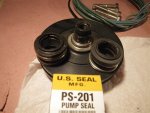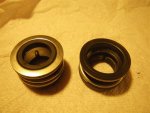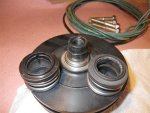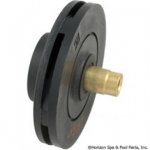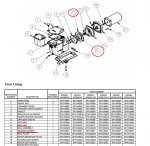I have an old SP2607X1 superpump with SP-1607-Z1-M motor. I’m replacing the motor with a new 2 speed STS1072R motor. I got the old motor off the pump and removed the wet end. I started to put everything together just to find out that the new seal doesn’t fit the impeller!
I got “HAYWARD PUMP SEAL SPX1600Z2 REPLACEMENT SHAFT SEAL†from here:
http://www.ebay.com/itm/ws/eBayISAPI.dll?ViewItem&item=320478175780#ht_899wt_777
The white/ceramic part fits fine, but the impeller side doesn’t! Thinking maybe I got the orientation wrong, I tried to flip it and still no dice.
Looking at the old and new one they seem quite different. The first pic on the bottom is the seals and the impeller (new seal is on the left)
I believe the top part of the seals on the picture are the ones facing the ceramic counterpart. You can see there are some ridges on the impeller and matching notches in the seal.
Second pic is one with the other side of the seal
The seals are quite different. The old one has a wider opening and the new one has a metal ring around it. The old one let the impeller shaft go thru the plastic body of it and then the ridges match the notches further down.
I looked around and spx1600Z2 seems to be the one for superpump. The other name is PS-201, which is what I have on the box. So what gives? I’m confused..
eidt: corrected the pump/motor model
I got “HAYWARD PUMP SEAL SPX1600Z2 REPLACEMENT SHAFT SEAL†from here:
http://www.ebay.com/itm/ws/eBayISAPI.dll?ViewItem&item=320478175780#ht_899wt_777
The white/ceramic part fits fine, but the impeller side doesn’t! Thinking maybe I got the orientation wrong, I tried to flip it and still no dice.
Looking at the old and new one they seem quite different. The first pic on the bottom is the seals and the impeller (new seal is on the left)
I believe the top part of the seals on the picture are the ones facing the ceramic counterpart. You can see there are some ridges on the impeller and matching notches in the seal.
Second pic is one with the other side of the seal
The seals are quite different. The old one has a wider opening and the new one has a metal ring around it. The old one let the impeller shaft go thru the plastic body of it and then the ridges match the notches further down.
I looked around and spx1600Z2 seems to be the one for superpump. The other name is PS-201, which is what I have on the box. So what gives? I’m confused..
eidt: corrected the pump/motor model


